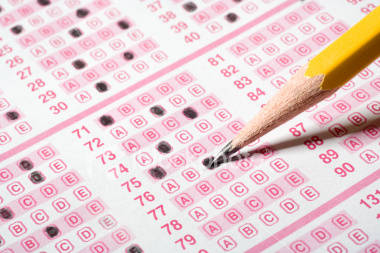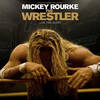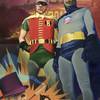The Multiple-Choice Test
"It was sometime in the spring, towards the end of my time in kindergarten. The twenty little people in my class, myself included, were being given a long, multiple choice test. We didn’t know exactly what it was for at the time, but we knew at it was some kind of Intelligence Quotient test. We were not yet old enough to adopt the cynical attitude of junior high school students, that any test that doesn’t count towards the grade is not worth taking, and we had a child’s eagerness to do well and to please the adults, so we attacked the long, complicated test with gusto. We were spread about the room with one empty seat between each student to discourage cheating. Our desks were full desks in miniature, not the awkward and uncomfortable chairs with the arm rests attached reserved for high school students and most college classrooms. The classroom, unimaginatively dubbed B5, was brightly lit, thanks to the presence of long, fluorescent ceiling lights and large windows on the left side of the room with the cream-colored shades pulled up all the way to let the maximum amount of daylight in. The room was decorated with posters that featured the letters of the alphabet, the months of the year, a color wheel with ROYGBIV labeled clearly, epigrams like the unattributed “To thine own self be true,” and a strategically placed American flag and portrait of President Reagan in the front, right-hand corner of the room next to the immense chalk board.
Mrs. Spector stood at the front of the room, watching the students closely with an expression that meant little to my five-year-old brain. Was she bored? Distrustful of us? Eager for us to do well and worried for us? I wasn’t very good at reading faces. I also had no idea how old she was or any thought of how old she was. She could have been anywhere from twenty-five to fifty, but my kid brain assumed that there were only a handful of possible ages people could be: five, forty, sixty, and one hundred. She wasn’t five, sixty, or a hundred, so I assumed she was forty, but she was probably around thirty-three. She had short, blonde hair, cut in the spiky style popular during the eighties. She wore a white, buttoned-down blouse, a knee-length black skirt, and a black leather vest. She didn’t always walk around carrying an enormous ruler that she used to point to words on the blackboard, but whenever I think of her, I think of her holding that ruler. As I took the test, I would look up at her occasionally, observe her clutching the ruler and standing with perfect posture beside the blackboard, and then I resumed my work on the test.
What I didn’t know at the time was what the test was for and who was administering it. I would find out years later, when I researched the program as a reporter for The Staten Island Advance. I did a lot of background digging, and pieced together a reasonably reliable chronology of events that led to the forming of a program for gifted youngsters. As it turned out, educators had designed it to select the members of the first-ever Advanced Learners, Early Childhood (ALEC) Classroom. ALEC was an initiative created by the Staten Island school district in response to pressures from child advocate groups, who lobbied for advanced education for gifted youngsters throughout the late nineteen-seventies. One of the head lobbyists was Carol Kasparian, founder of Concerned Citizens for the Education of Gifted and Talented Children, who was glad to see that the school district was finally taking steps to identify the roughly ten-to-fifteen percent of each school’s students that might be gifted, and ship them off to the three Staten Island schools that played host to ALEC, my school, PS 54 in the community called Willowbrook; PS 29, which served the neighborhoods that comprised Castleton Corners; and PS 42 in Eltingville. The district was not happy to make the concession, as it would wind up costing them $60,000 per gifted class each year, and the District Superintendent had decided early on that, at the first opportunity, he would try to end the program, claiming that it was too expensive. He would finally succeed in killing it off seventeen years later, and was unapologetic about it when I interviewed him on the topic. However, in 1981, ALEC was just getting started, and I had my crack at getting into in it on the ground floor with my fellow classmates. Those who scored the highest in my school would win the right to have Lillian Phillips as their first-grade teacher. Mrs. Phillips had studied methodologies for teaching the gifted at Columbia University, which emphasized special projects and field trips, discussion classes and experimentation, not learning by rote. Unfortunately, the entrance exam to get into the program was about as staid and unimaginative as one could get.
Carol was not happy with the selection procedure for ALEC, feeling it was exclusionary, favoring good test takers, instead of many genuinely gifted students who were too bored or reclusive to perform well in class, and did not take into account skills that can not easily be measured by a multiple-choice test, namely, critical thinking, writing skills, artistic aptitude, a good ear for music, and other signs of a right-brained individual.
So, I didn’t know any of this at the time, but I did know enough to get very angry at the test I was taking. If it was meant to examine my intelligence, it wasn’t doing a very good job. The questions were absurd, and many of them didn’t include the real correct answer as an option. I raised my hand, and Mrs. Spector approached. She stood over my desk, a tall, drink-of-water of indeterminate age, holding the ruler lazily at her side. “Yes?”
“Do we have to fill in the little circles next to the three answers they give us, or can we write the answer down next to the question?” I asked.
“It is a multiple choice test, Marc. You have to fill in the little circle next to the right answer and leave the wrong answers blank. You can’t write a different answer down.”
I looked back up at her, noticing the small brown birthmark next to the left corner of her mouth. “But the right answer isn’t there.”
“Of course it is there,” she said.
“But it isn’t.”
“Just take the test, Marc.”
She walked back to the front of the room.
I looked down at the question again.
23) How many times does a clock chime between 1:00 a.m. and 3:00 a.m.?
a) 4 times
b) 6 times
c) 2 times
The answer wasn’t there. I thought about it. The grandfather clock in my parent’s house chimed on the hour the number of chimes of that given hour. Two chimes for two o’clock, three chimes for three o’clock and so on. It also chimed once on every half hour. Therefore, between one o’clock and three o’clock, my clock would chime once at one o’clock, once at one thirty, twice at two o’clock, once at two thirty, and three times at three o’clock. So the clock would chime 1+1+2+1+3=8. The answer was eight. It wasn’t on the darn test. So I wrote the number eight in the margins next to the question and added the explanation “because of the half-hour chimes.”
The next few questions were pretty easy, so it was smooth sailing until I hit question 42, which also lacked a proper answer.
42) If Mary Johnson buys chocolates for $3 and bubble gum for $2 and spends $4 on a dress, how much money total does she spend on candy?
a) $5
b) $9
c) $6
Well, a dress isn’t candy, so I knew not to factor in the $4, which meant that choice b) was wrong. And choice a) would be right in a world where there was no sales tax, but everyone knew that you buy something and you have to pay sales tax. So that would bump up the price to five dollars and change. Would the answer be rounded up to six, and be choice c)? New York sales tax was something weird like eight-and-a-quarter cents for every dollar, so the answer would, technically, be around $5.46. And there was no $5.46 listed. So I raised my hand, and Mrs. Spector approached.
“Yes, Marc?”
“Do we round these answers up?”
She peered down at the test question, and gave me a quizzical look after reading it. “It is a simple question.”
“But do we leave out the sales tax, or not? If we leave out the sales tax, the right answer is there.”
Mrs. Spector smiled. “There’s no sales tax in this question.”
“But what kind of a world has no sales tax? That’s not a realistic question,” I complained,
Six-year-old Mitchell Sherry chimed in from two desks away. “There’s no sales tax in Delaware. And no tax on food in New York.”
Mrs. Spector looked sharply at Mitchell. “Concentrate on your test. No listening in.” She returned her eyes to mine. “Take the test. I can’t help you any more. I’m already talking to you too much. Just answer the questions.”
“I don’t like this test.” I slapped my pencil down in an attempt to be fierce and demonstrate my anger, but it made a weak slapping sound, not the thundercrack I was hoping for, and then rolled limply off the desk. I didn’t make a move to pick it up.
Mrs. Spector sat on her heels beside me and gingerly picked up the pencil with her free hand, depositing it neatly back on my desk. “Well, this is the test we’re all stuck with.”
I grumbled and went on to complete the test.
Four weeks later, Mrs. Spector gave us back the results. It was an official-looking paper intended for our parents to read, and written in an incomprehensible legalize. There were also a lot of graphs involved, which I have never been good at reading. After we were dismissed, we stood outside the school, alongside the gated playground, waiting for our parents to come pick us up. An army of cars were already parked around the school, and parents were honking their horns, gesturing wildly from passenger seat windows, and shouting their kids first names – which wasn’t very helpful given the number of Jennifers and Michaels running around on the loose. My mother was a little late, so I had time to stand outside and look over my results. There were a lot of percentages involved that I wasn’t getting. That’s when Mitchell Sherry strolled to a stop next to me.
* * *
My wife Stacey looked up from reading my story, "The Multiple-Choice Test."
"You're amazing," she said. "What ... did you write this in a half hour, or what?"
"I dunno," I said. "An hour. Two? Didn't time myself."
"Who writes something this good that fast?" she asked.
"So you liked it?" I asked, fishing for more compliments when the one I'd just heard should have more than satisfied me.
"You know I did."
"What was good about it?"
"It was great. A lot of fun."
"You have a favorite part?"
"I just like reading about your childhood. And I don't know how you remember all this."
"I remember most of it very well," I said. "The rest I fill in."
Stacey started to say something, but then stopped.
"What?" I asked.
"Nothing."
"What?"
"Well ... I do think you made the kindergartners too smart."
"That's how I remember us talking," I insisted. "We were gifted, after all."
"But the multiple-choice questions don't make sense."
"How so?"
"Kindergartners can't read. Or do math on that level. Maybe 1 + 1 = 2. Maybe that. Not doube-digits and sales tax."
"Kindergartners can't read?"
Stacey smirked. "Of course they can't."
"Wait a minute, wait a minute." I paused. "I learned to read in the first grade. I read a story about a kid who woudn't eat his beets and he had a dream about fighting giant living beets. I think it was called 'James and the Beets.' That was first or second grade. So how could there be verbal questions on the ALEC test?"
"That's what I'm saying. There couldn't have been."
"They must have been multiple-choice picture questions. Or maybe the teacher read the questions aloud and moved through the test slowly with us."
"So you made those questions up?"
"Nah. That was a real test I took. Must have been in the fourth grade, then. But I do remember that the ALEC test didn't test my strengths - writing, drawing, reading comprehension. It was all math and logic. Very sciency, not very artsy. I remember that for sure."
"Okay, I'll go with that. But they weren't these particular questions."
"They were of that ilk, but designed for kindergartners."
"Okay."
"So when I was retested in the third grade and given more creative writing, drawing, verbal, and audio-visual questions, I passed. If I had been given more math questions, I never would have gotten into ALEC, not even in the third grade."
Stacey nodded. "Well, you didn't get in as a kindergartner, but the story had a happy ending. You made it as a third grader."
"Yep. I made it into Hogwarts as a third grader. But the story doesn't have an entirely happy ending..."
...
to be continued...





































i-Italy
Facebook
Google+
This work may not be reproduced, in whole or in part, without prior written permission.
Questo lavoro non può essere riprodotto, in tutto o in parte, senza permesso scritto.